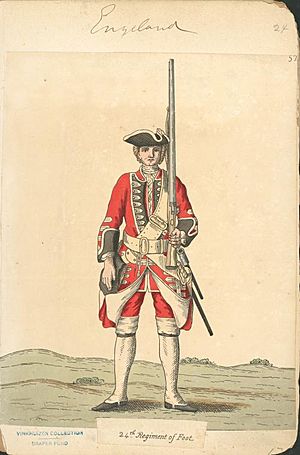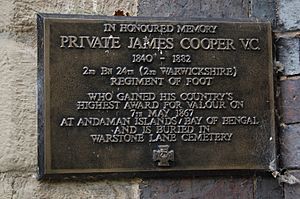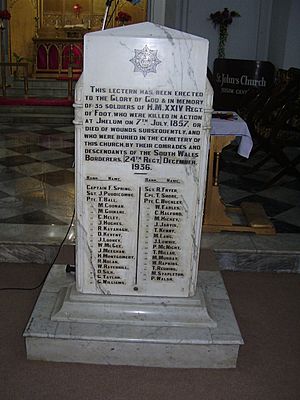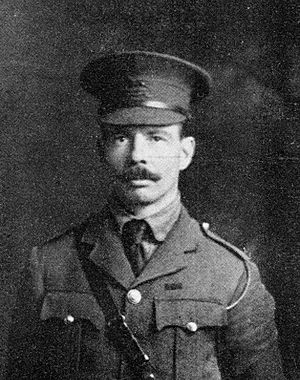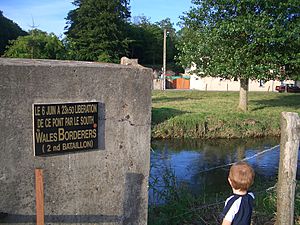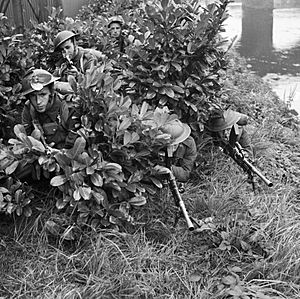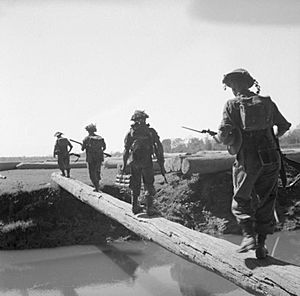South Wales Borderers facts for kids
Quick facts for kids 24th Regiment of Foot24th (The 2nd Warwickshire) Regiment of Foot South Wales Borderers |
|
|---|---|
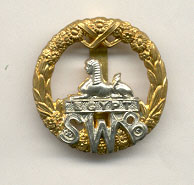
Cap badge
|
|
| Active | 1689–1969 |
| Country | |
| Branch | |
| Type | Infantry |
| Role | Line infantry |
| Garrison/HQ | The Barracks, Brecon |
| Nickname(s) | Howard's Greens |
| March | Men of Harlech |
| Anniversaries | Rorke's Drift (22 January) |
| Commanders | |
| Ceremonial chief | King Edward VIII |
The South Wales Borderers was a famous line infantry regiment of the British Army. It existed for 280 years, playing a big part in many historical events.
It started in England in 1689. Back then, it was called Sir Edward Dering's Regiment of Foot. Over time, it had different names and bases. In 1782, it became the 24th Regiment of Foot. Its main base was in Warwickshire.
From 1873, the regiment was based at Brecon in Wales. It recruited soldiers from nearby areas like Brecknockshire, Monmouthshire, and Herefordshire. It didn't get the name "South Wales Borderers" until 1881. The regiment fought in many wars. These included the American War of Independence, conflicts in India, the Zulu War, the Second Boer War, and both World War I and World War II. In 1969, the regiment joined with the Welch Regiment. Together, they formed the Royal Regiment of Wales.
Contents
- A Look Back: The Regiment's History
- Regimental Museum
- Special Awards: Victoria Cross Recipients
- Images for kids
A Look Back: The Regiment's History
How the Regiment Began
The regiment was created by Sir Edward Dering, 3rd Baronet in 1689. It was first known as Sir Edward Dering's Regiment of Foot. Like other regiments, its name often changed with its colonel (the person in charge).
The regiment fought in the Williamite War in Ireland. Later, it saw action in the War of the Spanish Succession. This included the Battle of Schellenberg in July 1704 and the Battle of Blenheim in August 1704.
In March 1741, the regiment was part of a sea and land attack in the Caribbean. They faced a tough defeat at the Battle of Cartagena de Indias during the War of Jenkins' Ear. In 1747, it was officially ranked as the 24th regiment. It became the 24th Regiment of Foot in 1751. It also fought in the Siege of Fort St Philip in 1756 during the Seven Years' War. Another difficult battle was the Battle of Saint Cast in France in September 1758.
In June 1776, the regiment went to Quebec. There, they fought American rebels during the War of Independence. In 1777, most of the regiment was captured by the Americans. They were part of a 5,000-strong British and German force. They remained prisoners until 1783. In 1782, it got a new name: the 24th (The 2nd Warwickshire) Regiment of Foot.
The regiment was sent to Egypt in 1801 after the Battle of Abukir. A second battalion was formed in 1804. This battalion lost many soldiers at the Battle of Talavera in July 1809 during the Peninsular War. In 1810, most of the first battalion was captured at sea by the French. They were on ships called Astell, Ceylon, and Windham. They were set free the next year. The first battalion also fought in the Anglo-Nepalese War in 1814. From 1829 to 1842, the regiment was stationed in Canada.
Battles in India: Sikh War and Mutiny
The regiment returned to India in 1846. They fought in the Second Anglo-Sikh War at the Battle of Chillianwala in January 1849. Here, 255 of their men died fighting bravely with bayonets.
Later, in May 1867, five Victoria Crosses were given to men of the regiment. They had rescued their friends from cannibals on the Andaman Islands. In July 1857, 35 soldiers of the regiment were killed by rebels in Jhelum. This happened during the Indian Rebellion. Among the dead was Captain Francis Spring.
The Zulu War: Isandlwana and Rorke's Drift
The Disaster at Isandlwana
In 1879, both battalions of the regiment fought in the Anglo-Zulu War. This war started when the British invaded Zululand, ruled by Cetshwayo. On January 11, the 24th Regiment of Foot crossed the Buffalo River into Zululand.
The first and worst battle for the British was at Isandlwana. The British set up camp but did not build strong defenses. This was because their force was large, the ground was hard, and they lacked tools. Most of the British force was from the 24th Foot. On January 22, the British commander, Lord Chelmsford, split his forces. He left the 1st Battalion (five companies) and one company of the 2nd Battalion to guard the camp. Lieutenant-Colonel Henry Pulleine was in command.
About 20,000 Zulu warriors attacked the British camp. The British force there was about 1,800 soldiers and 400 civilians. During the battle, Lieutenant-Colonel Pulleine told Lieutenants Coghill and Melvill to save the Queen's Colour (a special flag). The two Lieutenants tried to escape by crossing the Buffalo River. The flag fell into the river but was later found. Both officers were killed. At that time, the Victoria Cross (VC) was not given after death. This changed later, and both Lieutenants were given VCs for their bravery. The 1979 movie Zulu Dawn tells the story of the Battle of Isandlwana.
The Heroic Stand at Rorke's Drift
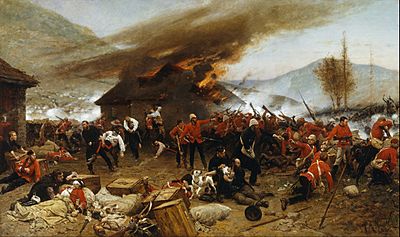
After the battle of Isandlwana, about 4,000 to 5,000 Zulus headed for Rorke's Drift. This was a small mission station. It was guarded by a company of the 2nd Battalion of the 24th Foot. There were also a few local soldiers and others. Lieutenant John Chard of the Royal Engineers was in command. The highest-ranking officer from the 24th there was Lieutenant Gonville Bromhead.
Two Boer cavalry officers arrived and told them about the defeat at Isandlwana. A supply officer, James Dalton, convinced Bromhead and Chard to stay and fight. The small group quickly built simple defenses.
The Zulus attacked at 4:30 pm. All day, the small group was attacked from every side. There was rifle fire from the hills and fierce hand-to-hand fighting. At one point, the Zulus entered the hospital. The wounded soldiers inside fought bravely until the building was set on fire. The battle lasted into the early morning of January 23. By dawn, the Zulu army had left. Lord Chelmsford and other British troops arrived soon after.
The defenders had 15 killed during the battle. Eleven defenders were given the Victoria Cross for their amazing bravery. Seven of these went to soldiers of the 24th Foot. The stand at Rorke's Drift was made famous in the 1964 movie Zulu.
Changes and New Conflicts
The regiment was not much changed by the Cardwell Reforms of the 1870s. These reforms gave it a base at The Barracks, Brecon from 1873. It also wasn't greatly affected by the Childers reforms of 1881. It already had two battalions, so it didn't need to join with another regiment.
However, it now had strong ties to South Wales. Several local soldier groups joined it. The 3rd Battalion was formed from the old Royal South Wales Borderers Militia. The 4th came from the Royal Montgomeryshire Rifles. It also had four (later five) Volunteer Battalions. Under these reforms, the regiment became The South Wales Borderers on July 1, 1881.
The 1st battalion was in Egypt from 1892. Then it moved to British India. It was stationed in places like Peshawar and later outside Lahore. The 2nd Battalion went to Burma and fought in the Third Anglo-Burmese War in November 1885.
The Second Boer War
The 2nd Battalion arrived in Cape Colony in early 1900. It fought in the Battle of Elands River in September 1901 during the Second Boer War. A special company of volunteers from the regiment's volunteer battalions joined the 2nd Battalion.
The 3rd Battalion was called up in January 1900. It sailed to South Africa in February, arriving in Cape Town in March. The 4th Battalion was called up for duty at home.
World War I: A Global Conflict
Regular Army Battalions
The 1st Battalion landed in France in August 1914. It was part of the British Expeditionary Force on the Western Front. The 2nd Battalion went to China in September 1914. It fought in the Siege of Tsingtao in October 1914 against German forces. After returning home in January 1915, the 2nd Battalion went to Gallipoli in April 1915. It was evacuated in January 1916 and then moved to France.
Reserve and Volunteer Battalions
The 3rd (Reserve) Battalion stayed in Britain. It defended the home front and sent thousands of new soldiers to the battalions fighting overseas.
The 1/1st Brecknockshire Battalion sailed to India in October 1914. It arrived in Bombay in December and then moved to Aden. After fighting in the Battle of Lahej in July 1915, it returned to Bombay. It stayed in Mhow until October 1919. It sent new soldiers to other battalions fighting in Mesopotamia and the Third Anglo-Afghan War.
Other battalions, like the 2/1st and 3/1st Brecknockshire Battalions, were formed to provide more soldiers. They later joined other Welsh reserve units.
New Army Battalions
Many new battalions were formed for the war. The 4th (Service) Battalion was created in August 1914. It landed in Gallipoli in July 1915. After being evacuated in January 1916, it moved to Egypt and then to Mesopotamia.
The 5th (Service) Battalion (Pioneers) landed in France in July 1915. The 6th (Service) Battalion (Pioneers) also landed in France in September 1915. Both served on the Western Front.
The 7th and 8th (Service) Battalions landed in France in September 1915. They then moved to Salonika in October 1915.
The 9th (Service) Battalion was formed in October 1914. It became a reserve battalion to supply soldiers to other units.
The 10th, 11th, and 12th (Service) Battalions were known as 'Pals battalions'. The 10th and 11th landed in France in December 1915. The 12th (Service) Battalion (3rd Gwent) was a 'Bantam battalion' (for smaller men). It landed in France in June 1916. Welsh poet Saunders Lewis served in the 12th Battalion during the war.
Other training battalions were also formed during the war.
Between the World Wars
The 1st Battalion went to Ireland in June 1920. Its job was to keep order during the Irish War of Independence. It was in County Meath from September 1920 to February 1922. Small groups also served in nearby towns. In 1934, it went to India. In February 1937, it was sent to Waziristan due to problems on the border.
The 2nd Battalion went to Barrackpore in India in 1919. It moved to various places like Jhansi and Delhi. In 1927, it was in Aden. It returned home to Portsmouth in February 1929. Its next overseas duty was in Malta in September 1935. Then it went to Palestine in 1936, returning home at the end of that year.
World War II: Fighting for Freedom
1st Battalion
The 1st Battalion was sent to Iraq in November 1941. Its mission was to stop a German-supported uprising. The battalion then served in Iran. It suffered huge losses in Libya near Tobruk. About 500 officers and men were captured or killed during a retreat. The battalion was cut off by German forces. The commanding officer decided to try to escape. This attempt failed, and only a few officers and about a hundred men reached safety.
To the surprise of the survivors, the battalion was ordered to disband in Cyprus. The remaining soldiers joined another regiment. Only a small group returned to the United Kingdom. A few months later, the battalion was re-formed. It was made up of the small group that returned and soldiers from another battalion.
2nd Battalion
When World War II started in September 1939, the 2nd Battalion was in Derry, Northern Ireland. In December 1939, it moved to join another brigade. In April 1940, the battalion joined the new 24th Guards Brigade. It took part in the Norwegian Campaign. They were among the first British troops to fight the German Army in World War II. The campaign failed, and the brigade had to leave. However, the battalion had very few casualties.
The 2nd Battalion returned to the United Kingdom. On December 7, 1941, it joined the 37th Independent Infantry Brigade. On March 1, 1944, the battalion moved to the 56th Independent Infantry Brigade. It trained for the invasion of Normandy. The battalion was the only Welsh battalion to take part in the Normandy landings on June 6, 1944. They landed at Gold Beach. They fought in the Battle of Normandy. In August 1944, it fought in the Battle of the Falaise Gap.
On August 20, the brigade joined the 49th (West Riding) Infantry Division. With this division, the battalion helped clear the Channel coast. They captured Le Havre in Operation Astonia. After a short rest, they moved to Belgium in September. In October, the division guarded the "Island" area between Arnhem and Nijmegen. The battalion's last major action was in April 1945. They fought in the Second Battle of Arnhem. The battalion ended the war in Germany. It stayed there as part of the occupation forces until 1948. During the war in North-western Europe, the battalion had more than 100% casualties (meaning many soldiers were replaced due to injuries or deaths).
6th Battalion
The 6th Battalion, South Wales Borders, served in the Burma Campaign. It was part of the 36th British Infantry Division.
7th Battalion
This battalion was formed in May 1940. It served in Home Defence. It then became part of the Royal Artillery in November 1941. It fought in Tunisia and Italy.
After the Wars: Post-1945 Service
The 1st Battalion went to Palestine in October 1945 to deal with unrest. It then moved to Cyprus in April 1946. The 2nd Battalion was disbanded in May 1948. This was due to defense cuts after World War II.
The regiment went to the Sudan in March 1949. In January 1950, it became part of the occupation force in Eritrea. This was a former Italian colony. The regiment arrived in Brunswick, West Germany, in January 1953. It was part of the British Army of the Rhine. In December 1955, it went to Malaya. This was to help with the Malayan Emergency. Field Marshal Sir Gerald Templer praised the regiment's actions during this time. He said, "there has been no better regiment in Malaya during the ten years of the emergency and very few as good."
The regiment was stationed in Minden, Germany, in June 1959. It returned home three years later. In November 1963, it arrived at Stanley Fort in Hong Kong. There, it performed internal security duties. It returned home to Lydd in Kent in June 1966. Then it went to Aden in January 1967.
The regiment joined with the Welch Regiment in June 1969. Together, they formed the Royal Regiment of Wales (24th/41st Foot).
Regimental Museum
You can learn more about the regiment at the Regimental Museum of The Royal Welsh (Brecon). It is located at The Barracks, Brecon, South Wales.
Special Awards: Victoria Cross Recipients
The Victoria Cross (VC) is the highest award for bravery in the British military. Many brave soldiers from the South Wales Borderers received this honor:
- Corporal William Wilson Allen
- Private David Bell
- Lieutenant Edward Stevenson Browne
- Temporary Lieutenant-Colonel Daniel Burges
- Lieutenant Nevill Josiah Aylmer Coghill
- Lieutenant Gonville Bromhead
- Temporary Captain Angus Buchanan
- Private James Cooper
- Assistant Surgeon Campbell Mellis Douglas
- Lieutenant Edric Frederick, The Lord Gifford
- Private James Henry Fynn
- Private William Griffiths
- Private Frederick Hitch
- Private Alfred Henry Hook
- Acting Lieutenant-Colonel Dudley Graham Johnson
- Private Robert Jones
- Private William Jones
- Lieutenant Teignmouth Melvill
- Private Thomas Murphy
- Sergeant Ivor Rees
- Sergeant Albert White
- Company Sergeant-Major John (Jack) Henry Williams
- Private John Williams
Images for kids



